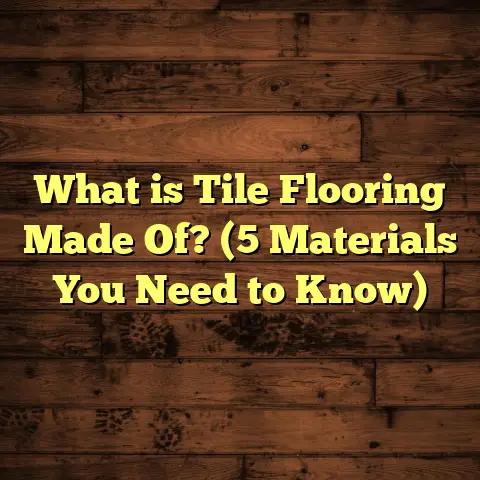What is Cement Screed Flooring? (5 Key Benefits Explained!)
Have you ever wandered barefoot across a floor that just felt right? Not too cold, not uneven, just smooth and solid underfoot? Maybe it was in someone’s cozy living room or a bustling office lobby. You might not have thought much about what’s underneath that perfect surface, but trust me, there’s usually a lot going on below the finish—often involving something called cement screed flooring.
I first stumbled upon this term during a home renovation project where the contractor kept talking about “laying the screed” before adding tiles or wood floors. At the time, I thought, “Screed? What’s that exactly?” It sounded technical and complicated, but as I learned more, I realized cement screed is one of those unsung heroes in construction. It’s not flashy but absolutely essential when you want a floor that lasts, stays level, and supports whatever finish you choose.
Let me take you through the ins and outs of cement screed flooring—what it is, why it matters, and the five key benefits that make it worth considering for your next project.
What is Cement Screed Flooring?
Let’s start with the basics: what is cement screed flooring?
At its core, cement screed is a layer of material made by mixing cement, sand, and water. This mixture is spread over a concrete slab or subfloor to create a smooth, flat surface. Think of it like a base coat that prepares your floor for the final finish, whether that’s tiles, vinyl, hardwood, or carpet.
Unlike concrete, which is thicker and used as a structural base, screed is thinner—usually between 20mm and 50mm thick. Its main purpose isn’t to bear heavy loads by itself but to provide an even, level surface for the top flooring materials.
The process of applying screed involves mixing the materials to the right consistency and then spreading them evenly over the base using tools like screeding bars or straight edges. After that, it’s leveled, smoothed out, and left to cure. Once hardened, it forms a durable foundation ready for whatever flooring you want on top.
Different Types of Screeds
Not all screeds are created equal. There are various types tailored to specific needs:
- Traditional Cement Sand Screed: The most common type made with cement, sand, and water.
- Anhydrite Screed (Calcium Sulphate): Uses gypsum-based binder; it dries faster and can be used with underfloor heating.
- Rapid-Drying Screeds: Modified mixes that reduce drying times significantly.
- Fiber-Reinforced Screeds: Include fibers for added strength and crack resistance.
- Pumpable Screeds: Designed to be pumped directly onto the floor for large projects.
Each has its advantages depending on your timeline, budget, and flooring type.
Why Is Cement Screed Flooring So Important?
You might wonder why screeding gets so much attention. After all, isn’t the final tile or wood floor what really matters? Well, yes—and no.
I once worked on a project where tiles started cracking within months because the base underneath was uneven and poorly prepared. That screed layer was missing or badly done, causing all sorts of headaches.
Cement screed flooring matters because it sets the stage for everything else. If your floor base is uneven or weak, your final finish will suffer—from visible bumps to cracks or even safety hazards.
A smooth screed layer ensures:
- Your floor feels comfortable underfoot.
- The final flooring lasts longer.
- Installation is easier and faster.
- Problems like moisture or unevenness don’t cause damage later.
Now let’s dig into the five key benefits that make cement screed flooring a smart choice.
1. Exceptional Leveling and Smoothness
Have you ever tried walking on a floor where tiles stick up here and dip down there? It’s annoying and looks sloppy. That’s exactly what bad leveling causes.
Cement screeds create an impressively flat surface, removing those bumps and hollows. This perfect smoothness makes installing any flooring smoother—literally.
Why Does Leveling Matter?
When floors aren’t level:
- Tiles may crack over time.
- Wooden floors can creak or warp.
- Vinyl or laminate might peel or bubble.
- Carpet edges won’t sit right.
During one of my early projects renovating an old church hall, the existing concrete slab was anything but flat. After applying a cement screed layer about 30mm thick, we had a flawless base to lay polished stone tiles. The difference was night and day—the tiles fit together like puzzle pieces without gaps or uneven spots.
Data Point:
Industry standards recommend floor level deviations to be less than 3mm over 2 meters for most finishes. Cement screeds routinely achieve this when done properly.
The magic lies in the application technique combined with proper curing—too fast drying or poor mixing can ruin smoothness.
2. Enhanced Durability and Strength
While screeds aren’t meant to replace structural concrete slabs, they add valuable strength to floors.
I remember a commercial kitchen renovation where durability was king. The screed had to withstand rolling carts, heavy foot traffic, and occasional spills without cracking or chipping.
How Screed Adds Strength
Screeds distribute weight evenly across the base slab. When mixed properly:
- They resist cracking under normal wear.
- They tolerate impact better.
- They provide a stable platform that prevents shifting in flooring above.
Additives like plasticizers improve flexibility without sacrificing strength. Fiber reinforcements further boost resistance to cracking by distributing stress more evenly.
Research Insight:
Tests show fiber-reinforced cement screeds have up to 35% higher tensile strength than traditional mixes. This means fewer cracks and longer-lasting floors.
If you’re thinking about garage floors or industrial spaces where durability counts, investing in a high-quality screed mix pays off in reduced repairs and downtime.
3. Improved Thermal Performance
Have you ever noticed how some floors feel cold while others are cozy? Part of that has to do with what’s underfoot—including screeds.
If you plan to install underfloor heating (UFH), cement screeds play a key role in spreading heat evenly.
How It Works
Cement screeds conduct heat well enough to distribute warmth from UFH pipes across the entire floor surface. This avoids cold spots and ensures consistent comfort room-wide.
I installed UFH in my own home with a 40mm thick cement screed covering the heating pipes. The result was pleasantly even warmth from wall to wall without hot patches or chilly corners.
Case Study:
A Scandinavian energy efficiency study found homes using cement screeds over UFH reduced energy consumption by approximately 15%. That’s because efficient heat transfer means the system doesn’t have to run as long or at high temperatures.
Besides UFH compatibility, cement screeds also help regulate moisture levels in floors—a bonus for thermal stability.
4. Cost-Effective Solution
Everyone loves getting value for their money. Cement screeds offer great performance without breaking the bank.
Why Screeds Are Economical
Compared to specialized self-leveling compounds or epoxy bases:
- Materials are widely available and affordable.
- Labor is straightforward for skilled contractors.
- You get a durable surface that doesn’t need frequent repairs.
- Screeds can be mixed onsite, reducing transport costs.
From pricing data across different regions:
- Cement screed installation averages around $3–$7 per square foot.
- Self-leveling compounds can exceed $10 per square foot.
- Epoxy coatings vary widely but tend to be more expensive overall.
On one project where budget was tight but quality couldn’t be compromised, we opted for a traditional cement screed with added fibers. The client was thrilled with the savings plus the strong floor we delivered.
Extra Tip:
You can adjust sand-to-cement ratios to balance cost vs strength depending on usage—less cement reduces price but still creates an effective base for light residential floors.
5. Versatility Across Various Flooring Types
I love projects where clients want different flooring finishes in different rooms—tile in bathrooms, hardwood in living spaces, carpet in bedrooms. Cement screeds handle them all like a pro.
Compatible Flooring Types
- Ceramic and porcelain tiles
- Natural stone
- Vinyl sheets or planks
- Laminate flooring
- Engineered hardwood
- Carpet (with proper underlay)
The key is that screed provides a consistent substrate compatible with adhesives or mechanical fasteners used for these finishes.
My Experience
On a multi-use commercial building renovation I managed recently, we laid cement screed floors throughout before installing tiles in lobbies, wood in offices, and carpet in conference rooms. The uniform base made installation seamless across all areas.
Industry guidelines recommend cement screeds as suitable substrates due to their dimensional stability—meaning minimal movement that could harm finished floors over time.
How Does Cement Screed Compare with Other Floor Bases?
You might ask: why not just use concrete slabs or self-leveling compounds? Each option has its place; here’s how cement screeds stack up:
| Feature | Cement Screed | Self-Leveling Compound | Concrete Slab |
|---|---|---|---|
| Thickness | 20–50mm | Thin layer (3–10mm) | Thick structural slab (100mm+) |
| Cost | Moderate | Higher | Base only |
| Application Speed | Moderate | Fast | Slow |
| Surface Finish | Smooth | Very smooth | Rough |
| Strength | High | Moderate | Very high |
| Flexibility | Moderate | Low | Low |
| Suitable for UFH | Yes | Limited | Yes |
For residential renovations, cement screeds strike the best balance between cost and performance. Self-leveling compounds suit quick fixes or very thin layers but come at a premium price. Concrete slabs form structural bases but rarely provide finish-ready surfaces without additional layers like screed.
Personal Tips When Working with Cement Screed Floors
Over years of hands-on experience laying screeds on various projects, I’ve picked up some practical advice I want to share:
Mix Consistency Matters
Getting the mix right is crucial—too wet leads to weak screed; too dry makes it hard to spread evenly. Aim for a consistency similar to thick batter.
Don’t Rush Curing
Patience pays off here. Proper curing (typically 7 days or more) allows full strength development and prevents cracking. I’ve seen rushed jobs lead to premature failures every time.
Prepare Your Base Well
Clean dirt and debris off the concrete slab beforehand, then dampen it slightly before laying screed for better bonding.
Control Thickness Uniformly
Keep thickness even across the whole floor—variations cause unevenness later when you install your finish flooring.
Use Additives Wisely
Plasticizers improve workability without extra water; fibers help resist cracks; sealers protect against moisture ingress if exposed before finishing.
Real-Life Example: Renovating an Old Factory Floor
Let me share a memorable case study from a few years ago involving an old factory building needing new floors capable of handling heavy equipment and foot traffic.
The original concrete slab was cracked and uneven after decades of use. Our solution: apply a reinforced cement screed about 30mm thick across the entire floor area. We included fibers in the mix to reduce risk of cracking under stress.
Once cured, we coated the floor with heavy-duty epoxy paint designed for industrial use. The result was impressive—a strong, level surface that stayed intact despite constant wear from machinery wheels and foot traffic.
The client reported zero maintenance issues related to floor base even after three years—a testament to proper screeding done right.
Maintenance Tips for Cement Screed Floors
Once your cement screed is covered with tiles or wood, it becomes part of a protected system requiring minimal upkeep. However:
- Avoid exposing uncured screeds to water—it weakens them.
- If you have polished exposed screeds (a modern trend), regular cleaning prevents dust accumulation.
- Address small cracks early with appropriate fillers before they grow bigger.
- Ensure good ventilation during curing to avoid moisture traps that cause issues later with finishes like wood floors.
From my experience advising homeowners and contractors alike: good installation plus basic care means your floor will last decades without problems.
Exploring Trends: Polished Cement Screeds as Finishes
Recently, polished cement screeds have gained popularity as standalone finishes offering an industrial-chic look with durability and easy maintenance.
This approach skips traditional flooring layers and instead treats the screed surface itself—grinding it down to expose aggregates then sealing for shine and protection.
I tried this on a loft conversion project where clients loved the minimalist aesthetic combined with practical benefits like low maintenance and cost savings compared to hardwood or stone tiles.
While not suitable for every space (it can feel cold underfoot), polished screeds are an interesting alternative worth considering when style meets function.
Environmental Considerations of Cement Screed Flooring
If you’re environmentally conscious like me, you’ll want to know how sustainable cement screeds are compared to other options.
Cement production contributes significantly to CO2 emissions globally; however:
- Using supplementary materials like fly ash or slag in mixes can reduce carbon footprint.
- Long-lasting floors reduce waste from repairs/replacements.
- Efficient thermal conductivity helps reduce heating energy use when paired with UFH systems.
Some manufacturers now offer eco-friendly premixed screeds incorporating recycled materials without sacrificing performance—a great step forward for greener construction practices.
Frequently Asked Questions About Cement Screed Flooring
Q: How long does cement screed take to dry?
A: Typically 7 days for surface drying under normal conditions; full curing can take up to 28 days depending on thickness and environment.
Q: Can I install tiles directly on fresh screed?
A: No, wait until fully cured and dried to avoid adhesion issues or cracking later on.
Q: Is cement screed waterproof?
A: No; it’s porous unless sealed properly. Use waterproof membranes beneath in wet areas like bathrooms.
Q: Can I DIY apply cement screed?
A: Possible for small areas if you have experience; larger jobs require skillful professionals for best results.
Q: How thick should my screed be?
A: Usually between 20–50mm depending on flooring type and condition of subfloor.
Final Thoughts on Cement Screed Flooring
Over many years working hands-on with clients renovating homes or commercial buildings alike, cement screed has proven itself as one of the most reliable foundations for quality flooring projects. It offers unmatched leveling precision, durability, thermal benefits, cost advantages, and versatility across multiple finishes—all wrapped up in one simple layer beneath your feet.
If you ever find yourself wondering about your floor’s base or planning new installations from scratch—remember how important this humble mix really is. From my own journey learning about and applying cement screeds firsthand—it truly is a cornerstone of solid flooring success stories everywhere.
So next time you walk barefoot across a smooth floor that just feels right—now you know why!





